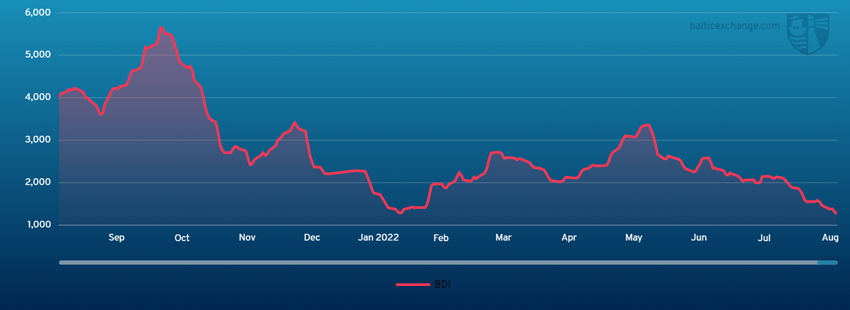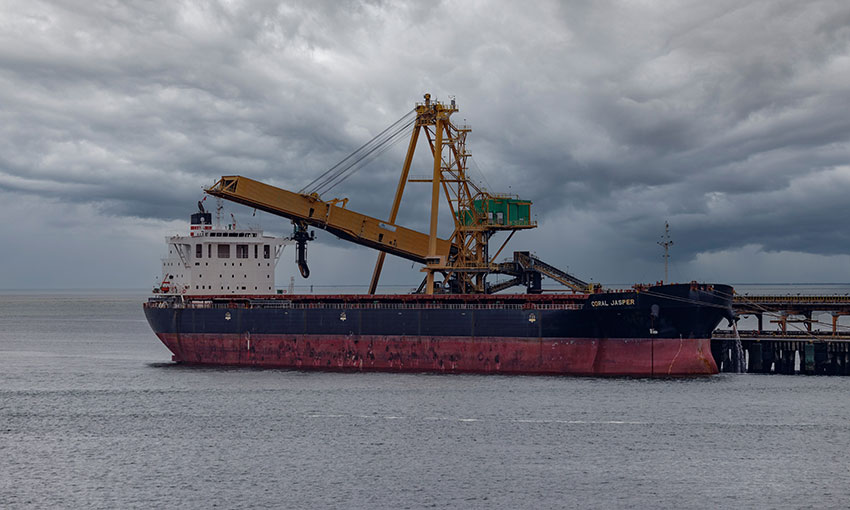THE Baltic Dry Index continued its weeks-long decline, hitting the lowest point in more than a year on Friday (19 August) when it hit 1279.

Capesize
The Capesize market continued to soften this week leaving little ambiguity about the state of the market as the 5TC posted at a low of $6267 on Friday. While the Pacific rates have already been bottoming out in recent times, the Atlantic trade routes were the movers this week shedding value as hopes of a trend-bucking rally diminish.
The trans-Atlantic lost -7833 week on week to settle at $7917. With minimal cargo out of Eastern Canada and the US, fronthaul valuations are now increasingly linking North Atlantic vessels to Brazil cargoes pushing the Fronthaul C9 route down to $24,563.
As iron ore prices and demand from China continue to struggle the talk of a stimulus package raises hopes, yet has little substance at this stage. As Capesize tonnage levels build in the Pacific, for the more constant stream of Australian iron ore cargoes the outlook for the remainder of Q3 looks dismal.
Panamax
We witnessed a very quiet start to the week – and it never really got going – with weakness shown across the board. Rates came off in both the Pacific and Atlantic basins. There was also talk of Ultramax vessels offering discounts for Charterers to consider, which further eroded rates as we witnessed falls on the Panamax routes all week. There was limited period activity, with a 10-year-old 82,000-dwt fixed for eight to 11 months at $17,000. There was some hope midweek in the Pacific basis NoPac and Indonesian demand. But this resulted in no positive moves and a widening bid-offer spread meant there was little fixing activity to report. Front haul trips from east coast South America were softening. And, as the tonnage list continues to grow, there could be further weakness towards the end of summer.
Ultramax/Supramax
Overall it was a rather optimistic week for the sector, despite summer holiday season in the Atlantic region, as sentiment moved into positive mode in many areas. Although period activity remained slow, a 53,000-dwt open Tuticorin was heard to have been fixed for three to five months trading in the low to mid teens. As the week closed, brokers said that more enquiry for September dates was entering the market from key areas such as the US Gulf although little fixtures surfaced. Better activity was also seen from the East Mediterranean, a 63,500-dwt fixed from here redelivery West Africa at $21,000. Stronger levels were also seen in Asia with tonnage availability becoming a bit “tight”, brokers said. A 58,000-dwt fixing from SE Asia via Indonesia redelivery CJK in the upper $20,000s. Further north, a 63,000-dwt was reported fixed delivery Mokpo for a trip via US NoPac redelivery Chittagong at $22,000. It remains to be seen if this trend will continue over the course of the upcoming week.
Handysize
A story of two halves. Some described the week as being the slowest for a number of months in the Atlantic. But by contrast, a tightening of tonnage availability and more enquiry from North Asia at the beginning of the week saw sentiment in the region gaining momentum. Whether this will be maintained during the upcoming week remains to be seen. From the Atlantic, very little fresh interest was seen from South America. A 33,000-dwt fixing delivery Fazedinha for a trip to the Mediterranean at $18,000. Downward pressure also remained from the Continent and Mediterranean. A 39,000-dwt fining a scrap run from Hamburg to the East Mediterranean at $14,000. Whilst a 34,000-dwt fixed a grains run from France to West Africa at $15,500. From Asia, little fresh information surfaced as many players kept fixtures under the radar. However, from the previous week it surfaced a 37,000-dwt open Dalian fixed a trip to the US Gulf in the low $18,000s.
Clean
The Middle East Gulf has remained relatively stable this week. TC1 has been trading sideways at the WS215 level with the round-trip TCE tipping over the $40,000 /day mark. TC20, 90kt AG/UK-Continent, begun to show signs of improvement at the back end of the week with the index rising $12,500 to $4.129m with reports of ship supply tightening. On the LR1s TC5 has floated around the mid WS260s all week and a trip west (TC8) has also held at the $3.7m – $3.75m mark.
The MRs have seen a significant improvement this week leading the TC17 index to have risen 45.84 points to WS339.17 by the end of the week. West of Suez the LR2s have suffered from a week of inactivity, TC15 has reached $3.69m (-$33,333) and remains to be tested properly at time of writing. On the LR1s TC16 has been flat at WS230 all week.
On the UK-Continent steady activity on the MRs has been outweighed by tonnage availability and subsequently rates have taken a downturn this week. TC2 has lost 78.89 points to WS248.33 and TC19 has similarly come down to WS254.29 (-WS81.42).
In the US Gulf the MRs have been tested down again this week. TC14 has dipped 32.5 points to settle at WS150.83 and TC18 has shed another 62.5 points ending up at WS220.83. After a sharp drop to these levels early in the week its looks as though this may be the floor for the moment.
The MR Atlantic Triangulation Basket TCE lost $13,031 from $38,060 to $25,029.
The Mediterranean Handymax market suffered from limited enquiry and ample vessels available this week. The TC6 Index has subsequently lost 54.38 points to end up at WS292.5. In the Baltic TC9 has continued along at WS500.
VLCC
VLCC rates were elevated this week across all regions as the markets resurged from a quiet end to last week. Increased Atlantic activity leading to improving rates meant the Middle East Gulf market had to compete. For 270,000mt Middle East Gulf/China, the rate rose from low WS60s early in the week, through WS70 midweek and has now settled around the WS80 mark (a round-trip TCE of $40,800 per day), while the rate for 280,000mt Middle East Gulf/USG (via Cape of Good Hope) climbed 9 points to WS46. In the Atlantic, rates for 260,000mt West Africa/China jumped 21 points to WS83 ($44,200 per day round-trip TCE) and 270,000mt US Gulf/China shot up $1.4 million to $9.0375 million (showing a round trip TCE of $31,900 per day).
Suezmax
Rates for 135,000mt Black Sea/Augusta stopped falling this week, and rose three points to WS172.5 (a round-trip TCE of $65,300 per day). The 130,000mt Nigeria/UKC trip rates leapt 12.5 points earlier in the week and have now settled at WS135 (a round-trip TCE of $36,800 per day). In the Middle East, the rate for 140,000mt Basrah/West Mediterranean recovered 4.5 points to just over WS65.
Aframax
The Mediterranean market rates regained some of the ground recently lost. The rate for 80,000mt Ceyhan/West Mediterranean rose seven points to WS186 (a round-trip TCE of $42,300 per day). In Northern Europe the market eased off with the rate for 80,000mt Hound Point/UK Continent dropping 4.5 points to WS180 (a daily round trip TCE of $48,300) and for the 100,000mt Primorsk/UK Cont route rates slipped two points to WS222 (a round-trip TCE of $71,400 per day).
Across the Atlantic, the market has continued on an upward trend. The rate for 70,000mt EC Mexico/US Gulf rose another 17.5 points to between WS385-387.5 (a round-trip TCE of $103,500 per day) and for the 70,000mt Caribbean/US Gulf trip the rate shifted up four points to WS332.5 (whilst earnings remained the same at a round-trip TCE of about $76,200). For the trans-Atlantic route of 70,000mt US Gulf/UK Continent, the rate rose two points to between WS262.5-265 ($52,000 per day round-tip TCE).

